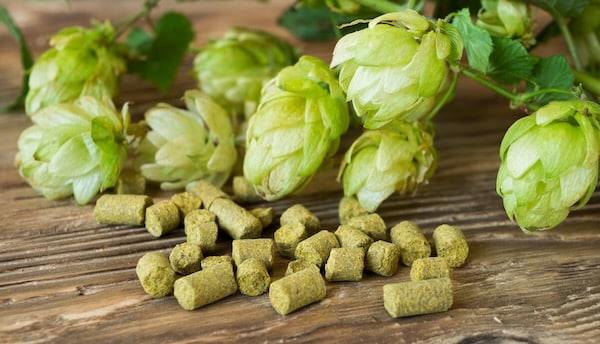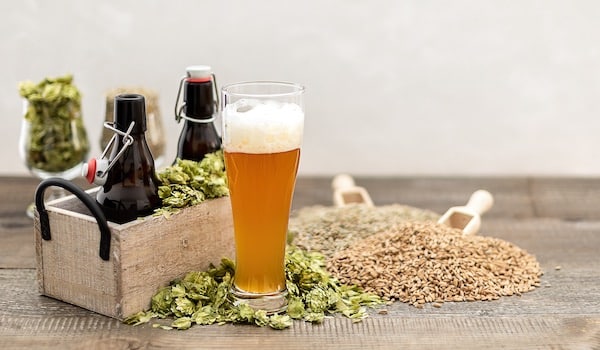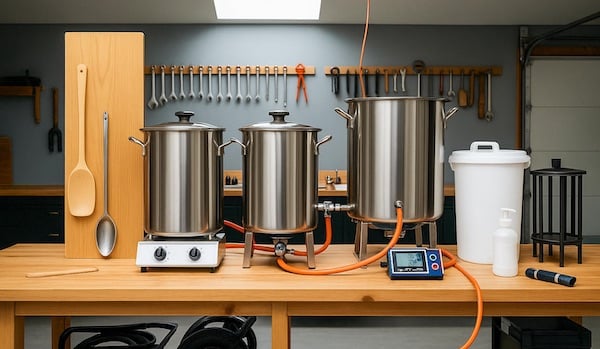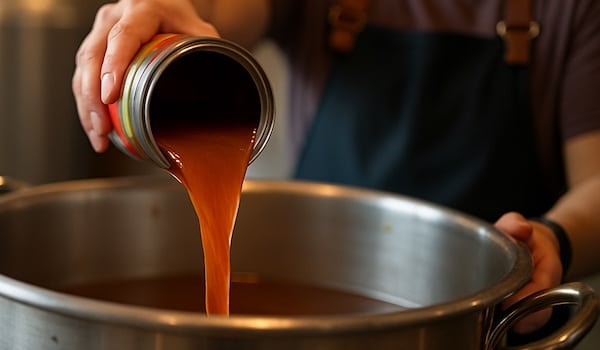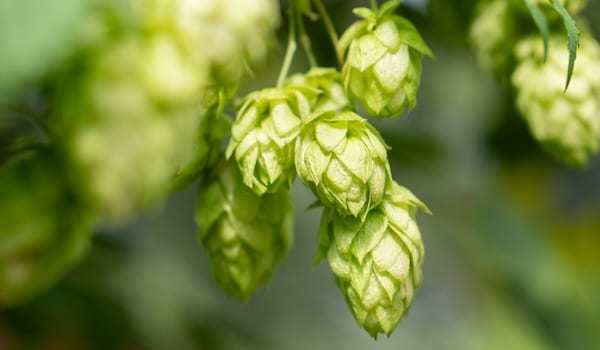
This article may contain affiliate links. If you click them, we may earn a small commission at no extra cost to you.
In This Article
- Introduction to Beer Hops
- What Are Hops and Why Do They Matter in Beer?
- The Main Categories of Hops
- Hop Flavor and Aroma Profiles
- Popular Hop Varieties Around the World
- Choosing the Right Hops for Your Brew
- Hop Pairing and Blending
- Final Thoughts on Hop Varieties
- Sign Up for Our Newsletter Here!
Introduction to Beer Hops
The craft beer industry, whether it’s the drinkers or brewers themselves, has never been more hop-obsessed. It’s understandable. Almost everyone involved can recall an “aha” moment where a classic West Coast IPA absolutely blew them away with piney bitterness and flavors like grapefruit or orange peel.
Although yeast and malt certainly play a role, these flavors are most often attributed to hops. This leads to an infatuation with the different varieties of hops that brewers use and often proudly display on cans and bottles. There’s an incredible variety throughout the pantheon of hops, some with amusing names or fascinating back stories, and others with centuries of history behind their renown.
Whether you’re looking to find your favorite hop to guide your beer drinking or brewing choices, there’s quite a bit to learn… Here’s everything you need to know about hops and hop varieties:
Helpful Home Brewing Resources
If you want to level up your home-brewing skills, check out the Craft Beer & Brewing membership. It gives you access to 100+ brewing courses, 400+ videos, step-by-step guides, and downloadable BeerSmith/BeerXML recipe files. You can also explore their full library of online brewing courses here.
👉 Explore the Craft Beer & Brewing membership
What Are Hops and Why Do They Matter in Beer?
Hops are the flowers of the Humulus Lupulus plant, native to Europe and North America. It’s now grown all over the world for its use in the brewing process. As an ingredient in beer, it has the following functions:
- Bitterness: The iso-alpha acids from hops are used to balance the malty sweetness of barley, wheat, or oats.
- Aroma: The essential oils from hops express floral or herbal aromas that range from pine and spice to even tropical fruit.
- Flavor: Similar to aromatics, both the essential oils and alpha acids from hops evoke floral, fruity, spicy, etc. flavors that are perceived on the tongue. The flavors themselves are derived when the hops are added during the boil or later in the brewing process.
- Preservation: Hops do have some antimicrobial properties that can prevent spoilage, and one of the initial purposes for hops was to preserve beer for long voyages or storage.
RELATED ARTICLE:
The Main Categories of Hops
Bittering Hops
High alpha acids contribute bitter tastes, which are measured as IBUs (or international bitterness units). These hops are used early in the boil to extract the alpha acids.
Aroma Hops
These hops, lower in alpha acids, are added later in the brewing process to keep aromatic essential oils, which contribute desirable flavors and scents to the beer. This is where methods like dry hopping come into play.
Dual-Purpose Hops
These are hops used for both bitterness and aroma. These can be added at any point in the brewing process, depending on the brewer’s aims.
Hop Category Breakdown
| Category | Alpha Acid Range | Usage | Examples |
|---|---|---|---|
| Bittering Hops | 5% to 13% | The high alpha acid content adds bitterness to the beer. | Magnum, Columbus (CTZ), Nugget |
| Aroma Hops | 3% to 9% | The aromatic essential oils contribute desirable flavors and scents. | Saaz, Hallertau |
| Dual-Purpose Hops | 4% to 10% | Perform both bittering and aroma roles depending on when they’re added. | Citra, Cascade |
Hop Flavor and Aroma Profiles
| Flavor Family | Example Hops | Typical Descriptors |
|---|---|---|
| Citrus | Cascade, Amarillo, Centennial | Grapefruit, Orange, Lemon, Lime |
| Tropical Fruit | Citra, Mosaic, Galaxy | Mango, Pineapple, Passionfruit, Lychee |
| Pine / Resinous | Simcoe, Chinook, Columbus | Pine, Resin, Earthy |
| Floral / Herbal | Saaz, Hallertau, East Kent Goldings | Floral, Herbal, Spicy, Perfumed |
| Spicy / Earthy | Fuggle, Tettnang, Perle | Earthy, Peppery, Woody, Slightly Bitter |
| Berry / Stone Fruit | El Dorado, Vic Secret, Idaho 7 | Blueberry, Cherry, Apricot, Red Fruit |
| Tropical Citrus Mix | Nelson Sauvin, Motueka | Passionfruit, Gooseberry, Lime, Grapefruit |
Citrus Hops
These hops offer magnificent grapefruit, lime, orange, and lemon flavors for IPAs and pale ales. They’re increasingly used in hoppy lagers like the trendy “West Coast Pils.”
Tropical Fruit Hops
For juicy New England IPAs, this family of hops brings mango, pineapple, and passionfruit aromas.
Pine / Resinous Hops
Classic West Coast IPAs will have pungent aromas often referred to as “dank.” Some beer drinkers will find similarities to cannabis (a plant hops are closely related to).
Floral / Herbal Hops
These are used in traditional European lagers, especially in hoppy pilsners. The Noble hop varieties are most often associated with these flavors.
Spicy / Earthy Hops
The more complex English ales and porters will have vegetal or earthy flavors that interact well with the malt sweetness for a rich flavor.
Popular Hop Varieties Around the World
American Hops
Reflective of the creative US craft beer scene, American hops provide some of the most vibrant and strong flavors and aromas of any hop region. Expect big flavors in the form of citrus, pine, resin, and tropical fruit. These varieties have defined the bold flavors of West Coast IPA and are now employed in hazy beers for their mango and passionfruit aromas.
Examples: Cascade, Citra, Mosaic (bold citrus/tropical/pine)
European Hops
The low alpha acids of “Noble” hops provide subtle aromas and an approachable bitterness. These are designed for lagers, but you can find some nice peppery flavor and spice.
Examples: Saaz, Hallertau, Tettnang (delicate floral/herbal)
Australian & NZ Hops
Some of the trendiest hops on the market, Southern Hemisphere staples from New Zealand, provide “bright” tropical, citrus, and white wine-like flavors most reminiscent of Sauvignon Blanc grapes. These hops are super aromatic with a dry finish and clean bitterness.
Examples: Galaxy, Nelson Sauvin, Motueka (tropical fruit)
UK Hops
There’s nothing too sexy about UK hops, but they provide a measured dose of flavor and aromas that work well in malt-forward ales like ESB or porter. Expect earthy and herbal aromas with hints of honey and floral spice.
Examples: Fuggle, East Kent Goldings (earthy/herbal)
Choosing the Right Hops for Your Brew
Lager & Pilsner
You want “clean” flavors with low bitterness, and a mild aroma that won’t overpower the malt.
Best Hops: Saaz (earthy and herbal) and Hallertau Mittelfrüh (spicy and floral).
IPAs
You want flavors and aromas to really pop. Classic IPAs will have more bitterness, while NEIPAs will have huge, juicy flavors.
Best Hops: Citra (mango, lime, passionfruit), Mosaic (fruity), Simcoe (citrus and pine), and Amarillo (floral and aromatic).
Pale Ales
You’ll want some light bitterness to balance out the malt sweetness. Floral and citrusy aromatics should have a dry finish.
Best Hops: Cascade (grapefruit and pine), Centennial (resinous and bitter), and Chinook (spice).
Stouts & Porters
The strong malt characteristics of these dark beers need a subtle hop presence and bitterness for balance.
Best Hops: Fuggle (woody), Willamette (grassy and spicy), and East Kent Goldings (floral and bitter).
Sour & Wheat Beers
To play off the softer flavors of wheat or the tartness of a sour beer, fruity hop flavors are ideal.
Best Hops: El Dorado (pineapple), Galaxy (passionfruit and peach), and Cashmere (lime).
Hop Pairing and Blending
While there are plenty of amazing examples of single-hop beers, combining two or more varieties can unlock vibrant flavors and aromas. For brewers, this is where their inner “mad scientist” gets unleashed. Here are a few common combinations:
- Citra + Mosaic: Juicy IPAs
- Amarillo + Simcoe: Citrus and pine for West Coast IPAs and pale ales
- Saaz + Hallertau: Traditional lagers and pilsners
- Nelson Sauvin + Citra: Ideal for New England IPAs or even wild ales
- Strata + Citra: “Dank” American IPAs
Final Thoughts on Hop Varieties
While malt, yeast, brewing know-how, and even water all contribute to the magic that is a well-brewed beer, it’s unsurprising that hops command so much attention (and affection) from both producers and drinkers. These little green nuggets are jam-packed with flavor and offer a window into not only a brewery, but also the farms they’re grown on. Exploring new hop varieties (luckily, there are new ones developed every year) is one of the true joys of craft beer. Whether you’re looking for an explosion of juice from a hypeworthy hazy IPA or the subtle hop-bite from a traditional pilsner, make sure you’re sipping thoughtfully and seeking out new flavors!
If you want to build deeper brewing skills, Craft Beer & Brewing’s membership is honestly one of the best brewing education resources online.
What’s your favorite hop variety or combo? Tried any new hops recently? Share it in the comments! If you’re brewing your own, join our newsletter for tips, hop guides, and recipe ideas!

